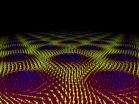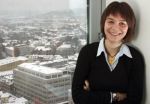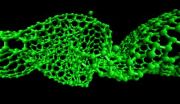(Press-News.org)
VIDEO:
In this animated illustration, an electron (black ball) flies across a lattice of magnetic vortices. The forces transferred in the process allow the magnetic structures to be controlled with relatively...
Click here for more information.
One of the requirements to keep trends in computer technology on track – to be ever faster, smaller, and more energy-efficient – is faster writing and processing of data. In the Dec. 17 issue of the journal Science, physicists at the Technische Universitaet Muenchen (TUM) and the Universitaet zu Koeln report results that could point the way to a solution. TUM physicists set a lattice of magnetic vortices in a material in motion using electric current almost a million times weaker than in earlier studies. They observed the coupling between electric current and magnetic structure by means of measurements at the research neutron source FRM II at the TUM in Garching.
While Peter Gruenberg and Albert Fert were awarded the Nobel Prize in 2007 for research that led to significantly faster reading of data, in the past few years scientists have been concentrating on how magnetic information can be directly written to media using electric current. So far, the problem with this kind of work has been the need for extremely high currents, whose side effects are nearly impossible to rein in, even in nanostructures.
A little over a year ago, Professor Christian Pfleiderer and his team at the Physics Department of the TUM discovered an entirely new magnetic structure in a crystal of manganese silicon – a lattice of magnetic vortices. The experiments in Garching were spurred by the theoretical forecasts of Professor Achim Rosch at the Universitaet zu Koeln and Professor Rembert Duine from the Universiteit Utrecht. They were expecting new results in the field of so-called spintronics, nanoelectronic elements that use not only the electric charge of electrons to process information, but also their magnetic moment, or spin.
Christian Pfleiderer's team of scientists sent electric current through the manganese silicon. Using neutrons from FRM II, they were able to observe a twist in the magnetic vortex lattice, which they could not explain initially. More interesting than the twist was the newly discovered magnetic lattice (Science, Vol. 323, 5916 pp. 915-919, see below).
In the next step, Christian Pfleiderer and his team made further measurements at the MIRA instrument of the neutron source FRM II in an attempt to determine why the lattice twisted when a current was applied. At first, the calculations of the theoreticians contradicted the results of the experiments in Garching. "The magnetic structure twists, because the direction of the electric current is deflected extremely efficiently by quantum mechanical effects," explains Christian Pfleiderer. When an electron flies through the magnetic vortex, the electron's spin reacts to the vortex (see animation). In this way the electric current exerts a force on the magnetic vortices, which eventually begin to flow.
After further measurements, the team of Christian Pfleiderer and Achim Rosch was able to establish that the newly discovered lattice of magnetic vortices displays properties that have been of interest in nanotechnology for quite some time. They are, among other things, relevant to the development of new data storage systems. Notably, the magnetic vortices are very stable and at the same time very weakly anchored in the material, so that even the weakest of electric currents can lead to movement. This should allow data to be written and processed considerably faster and more efficiently in the future.
INFORMATION:
Original publication:
F. Jonietz, S. Mühlbauer, C. Pfleiderer, A. Neubauer, W. Münzer, A. Bauer, T. Adams, R. Georgii, P. Böni, R. A. Duine, K. Everschor, M. Garst, A. Rosch, Spin Transfer Torques in MnSi at Ultra-low Current Densities, Science, 330, 6011, 17 December 2010,
Publication about the discovery:
Skyrmion Lattice in a Chiral Magnet; S. Mühlbauer, B. Binz, F. Jonietz, C. Pfleiderer, A. Rosch, A. Neubauer, R. Georgii, P. Böni, Science, Vol. 323 no. 5916 pp. 915-919, 13 February 2009 –DOI: 10.1126/science.1166767
Link: http://www.sciencemag.org/content/323/5916/915.abstract
Press release: http://portal.mytum.de/pressestelle/pressemitteilungen/news_article.2009-02-11.2064891806/newsarticle_view
Images and animation:
http://mediatum2.ub.tum.de/node?cfold=1006342&dir=1006342&id=1006342
Contact:
Prof. Christian Pfleiderer
Department of Physics
Technische Universitaet Muenchen
James-Franck-Str. 1, 85748 Garching, Germany
Tel.: +49 89 289 14720
E-Mail: christian.pfleiderer@frm2.tum.de
Internet: http://www.e21.ph.tum.de
Technische Universitaet Muenchen (TUM) is one of Europe's leading universities. It has roughly 460 professors, 7,500 academic and non-academic staff (including those at the university hospital "Rechts der Isar"), and 26,000 students. It focuses on the engineering sciences, natural sciences, life sciences, medicine, and economic sciences. After winning numerous awards, it was selected as an "Elite University" in 2006 by the Science Council (Wissenschaftsrat) and the German Research Foundation (DFG). The university's global network includes an outpost in Singapore. TUM is dedicated to the ideal of a top-level research based entrepreneurial university. http://www.tum.de
Electric current moves magnetic vortices
With the help of neutrons, TUM physicists discover new ways to save data
2010-12-18
ELSE PRESS RELEASES FROM THIS DATE:
Samples of vital human tumor tissue irradiated with ions for the first time
2010-12-18
Cancer treatment with ion beams developed at GSI is characterized by an excellent cure rate and only minor side effects. The therapy has been routinely in use for a little over one year. The effectiveness of the ion beams not only depends on the tumor type, but also on the genetic disposition and the personal circumstances of the individual patient. For the first time, scientists at GSI Helmholtzzentrum für Schwerionenforschung have irradiated samples of vital human tumor tissue in the scope of their systematical and fundamental research. Their long-term goal is to enhance ...
How plants counteract against the shade of larger neighbors
2010-12-18
Plants that "lose the battle" during competitiveness for light because they are shaded by larger neighbours, counteract. They adapt by rapid shoot elongation and stretch their leaves towards the sun. The molecular basis of this so-called shade avoidance syndrome had been unclarified to date. Research scientists from the Utrecht University in the Netherlands and the Ruhr University in Bochum have now been able to unravel a regulation pathway. A specific transport protein (PIN3) enables the accumulation of the plant hormone auxin, which plays an important role during this ...
Typically Italian, isn't it?
2010-12-18
"I have ready!" With this sentence the FC Bayern Munich coach Giovanni Trapattoni finished a furious rant about his team's performance in 1998. And "Mr Angelo" in a coffee advert points out to his neighbour with a mischievous smile: "I don't have a car at all". In both cases the Italians are unmistakeably recognizable and so the exuberant temperament of the first and the charming way of the second are seemingly "typically Italian".
The accent someone talks in plays a crucial role in the way we judge this person, psychologists of the Friedrich Schiller University Jena ...
How do you cut a nanotube? Lots of compression
2010-12-18
VIDEO:
Compression causes nanotubes to buckle and twist and eventually to lose atoms from their lattice-like structure.
Click here for more information.
PROVIDENCE, R.I. [Brown University] — A pipefitter knows how to make an exact cut on a metal rod. But it's far harder to imagine getting a precise cut on a carbon nanotube, with a diameter 1/50,000th the thickness of a human hair.
In a paper published this month in the British journal Proceedings of the Royal Society ...
K-State research looks at pathogenic attacks on host plants
2010-12-18
MANHATTAN, KAN. -- Two Kansas State University researchers focusing on rice genetics are providing a better understanding of how pathogens take over a plant's nutrients.
Their research provides insight into ways of reducing crop losses or developing new avenues for medicinal research.
Frank White, professor of plant pathology, and Ginny Antony, postdoctoral fellow in plant pathology, are co-authors, in partnership with researchers at three other institutions, of an article in a recent issue of the journal Nature. The article, "Sugar transporters for intercellular exchange ...
Study reveals major shift in how eczema develops
2010-12-18
Like a fence or barricade intended to stop unwanted intruders, the skin serves as a barrier protecting the body from the hundreds of allergens, irritants, pollutants and microbes people come in contact with every day. In patients with eczema, or atopic dermatitis, the most common inflammatory human skin disease, the skin barrier is leaky, allowing intruders – pollen, mold, pet dander, dust mites and others – to be sensed by the skin and subsequently wreak havoc on the immune system.
While the upper-most layer of the skin – the stratum corneum – has been pinned as the ...
Ancient raindrops reveal a wave of mountains sent south by sinking Farallon plate
2010-12-18
50 million years ago, mountains began popping up in southern British Columbia. Over the next 22 million years, a wave of mountain building swept (geologically speaking) down western North America as far south as Mexico and as far east as Nebraska, according to Stanford geochemists. Their findings help put to rest the idea that the mountains mostly developed from a vast, Tibet-like plateau that rose up across most of the western U.S. roughly simultaneously and then subsequently collapsed and eroded into what we see today.
The data providing the insight into the mountains ...
Computer games and science learning
2010-12-18
Computer games and simulations are worthy of future investment and investigation as a way to improve science learning, says LEARNING SCIENCE: COMPUTER GAMES, SIMULATIONS, AND EDUCATION, a new report from the National Research Council. The study committee found promising evidence that simulations can advance conceptual understanding of science, as well as moderate evidence that they can motivate students for science learning. Research on the effectiveness of games designed for science learning is emerging, but remains inconclusive, the report says.###
The report is available ...
You only live once: our flawed understanding of risk helps drive financial market instability
2010-12-18
Our flawed understanding of how decisions in the present restrict our options in the future means that we may underestimate the risk associated with investment decisions, according to new research by Dr Ole Peters from Imperial College London. The research, published today in the journal Quantitative Finance, suggests how policy makers might reshape financial risk controls to reduce market instability and the risk of market collapse.
Investors know that there are myriad possibilities for how a financial market might develop. Before making an investment, they try to capture ...
Efficient phosphorus use by phytoplankton
2010-12-18
Rapid turnover and remodelling of lipid membranes could help phytoplankton cope with nutrient scarcity in the open ocean.
A team led by Patrick Martin of the National Oceanography Centre has shown that a species of planktonic marine alga can rapidly change the chemical composition of its cell membranes in response to changes in nutrient supply. The findings indicate that the process may be important for nutrient cycling and the population dynamics of phytoplankton in the open ocean.
Tiny free-floating algae called phytoplankton exist in vast numbers in the upper ocean. ...
LAST 30 PRESS RELEASES:
Injectable breast ‘implant’ offers alternative to traditional surgeries
Neuroscientists devise formulas to measure multilingualism
New prostate cancer trial seeks to reduce toxicity without sacrificing efficacy
Geometry shapes life
A CRISPR screen reveals many previously unrecognized genes required for brain development and a new neurodevelopmental disorder
Hot flush treatment has anti-breast cancer activity, study finds
Securing AI systems against growing cybersecurity threats
Longest observation of an active solar region
Why nail-biting, procrastination and other self-sabotaging behaviors are rooted in survival instincts
Regional variations in mechanical properties of porcine leptomeninges
Artificial empathy in therapy and healthcare: advancements in interpersonal interaction technologies
Why some brains switch gears more efficiently than others
UVA’s Jundong Li wins ICDM’S 2025 Tao Li Award for data mining, machine learning
UVA’s low-power, high-performance computer power player Mircea Stan earns National Academy of Inventors fellowship
Not playing by the rules: USU researcher explores filamentous algae dynamics in rivers
Do our body clocks influence our risk of dementia?
Anthropologists offer new evidence of bipedalism in long-debated fossil discovery
Safer receipt paper from wood
Dosage-sensitive genes suggest no whole-genome duplications in ancestral angiosperm
First ancient human herpesvirus genomes document their deep history with humans
Why Some Bacteria Survive Antibiotics and How to Stop Them - New study reveals that bacteria can survive antibiotic treatment through two fundamentally different “shutdown modes”
UCLA study links scar healing to dangerous placenta condition
CHANGE-seq-BE finds off-target changes in the genome from base editors
The Journal of Nuclear Medicine Ahead-of-Print Tip Sheet: January 2, 2026
Delayed or absent first dose of measles, mumps, and rubella vaccination
Trends in US preterm birth rates by household income and race and ethnicity
Study identifies potential biomarker linked to progression and brain inflammation in multiple sclerosis
Many mothers in Norway do not show up for postnatal check-ups
Researchers want to find out why quick clay is so unstable
Superradiant spins show teamwork at the quantum scale
[Press-News.org] Electric current moves magnetic vorticesWith the help of neutrons, TUM physicists discover new ways to save data


